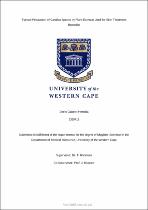| dc.contributor.advisor | Rahiman, Farzana | |
| dc.contributor.author | Heredia, Dario Gabriel | |
| dc.date.accessioned | 2022-06-30T08:35:38Z | |
| dc.date.available | 2022-06-30T08:35:38Z | |
| dc.date.issued | 2022 | |
| dc.identifier.uri | http://hdl.handle.net/11394/9138 | |
| dc.description | >Magister Scientiae - MSc | en_US |
| dc.description.abstract | The fungal genus Candida is a collection of approximately 150 asporogenous yeast species which are able to cause life-threatening diseases when the normal host defences have been compromised. The most commonly isolated species is Candida albicans (C. albicans), which is a dimorphic fungus that exists in the blastopore and mycelial phase. Factors which are critical for the pathogenicity of Candida are morphological transition between yeast and hyphal forms, thigmotropism, biofilm formation, expression of adhesins, invasins on the cell surface and the secretion of hydrolytic enzymes such as phospholipases, proteases, and haemolysin. | en_US |
| dc.language.iso | en | en_US |
| dc.publisher | University of the Western Cape | en_US |
| dc.subject | Candida | en_US |
| dc.subject | Skin treatment remedies | en_US |
| dc.subject | Tyrosol | en_US |
| dc.subject | Galenia africana | en_US |
| dc.subject | Yeast | en_US |
| dc.title | Tyrosol production of Candida species by plant extracts used for skin treatment remedies | en_US |
| dc.rights.holder | University of the Western Cape | en_US |

